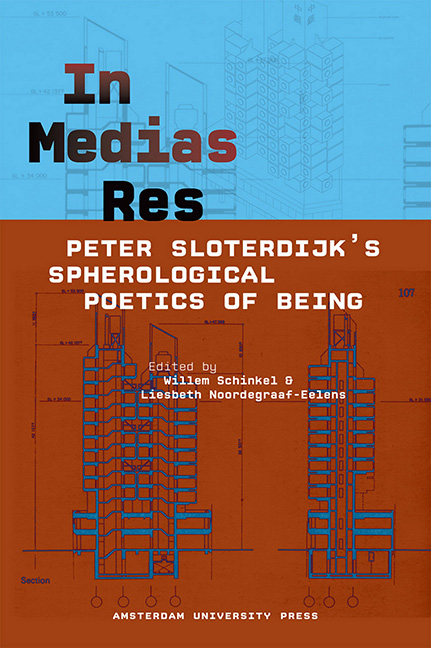Book contents
- Frontmatter
- Contents
- 1 Peter Sloterdijk’s Spherological Acrobatics: An Exercise in Introduction
- 2 Foamy Business: On the Organizational Politics of Atmospheres
- 3 “Transgenous Philosophy”: Post-humanism, Anthropotechnics and the Poetics of Natal Difference
- 4 Disinhibition, Subjectivity and Pride. Or: Guess Who Is Looking?: Peter Sloterdijk’s reconstruction of ‘thymotic’ qualities, psychoanalysis and the question of spectatorship
- 5 Sloterdijk and the Question of an Aesthetic
- 6 Uneasy Places. Monotheism, Christianity, and the Dynamic of the Unlikely in Sloterdijk’s Work – Context and Debate
- 7 The Attention Regime: On Mass Media and the Information Society
- 8 In the Beginning was the Accident: The Crystal Palace as a Cultural Catastrophe and the Emergence of the Cosmic Misfit: A critical approach to Peter Sloterdijk’s Weltinnenraum des Kapitals vs. Fyodor M. Dostoevsky’s Notes from the underground
- 9 A Cautious Prometheus? A Few Steps Toward a Philosophy of Design with Special Attention to Peter Sloterdijk
- 10 Sloterdijk and the Question of Action
- 11 The Space of Global Capitalism and its Imaginary Imperialism: An Interview with Peter Sloterdijk
- Contributors
- Index
9 - A Cautious Prometheus? A Few Steps Toward a Philosophy of Design with Special Attention to Peter Sloterdijk
Published online by Cambridge University Press: 23 June 2021
- Frontmatter
- Contents
- 1 Peter Sloterdijk’s Spherological Acrobatics: An Exercise in Introduction
- 2 Foamy Business: On the Organizational Politics of Atmospheres
- 3 “Transgenous Philosophy”: Post-humanism, Anthropotechnics and the Poetics of Natal Difference
- 4 Disinhibition, Subjectivity and Pride. Or: Guess Who Is Looking?: Peter Sloterdijk’s reconstruction of ‘thymotic’ qualities, psychoanalysis and the question of spectatorship
- 5 Sloterdijk and the Question of an Aesthetic
- 6 Uneasy Places. Monotheism, Christianity, and the Dynamic of the Unlikely in Sloterdijk’s Work – Context and Debate
- 7 The Attention Regime: On Mass Media and the Information Society
- 8 In the Beginning was the Accident: The Crystal Palace as a Cultural Catastrophe and the Emergence of the Cosmic Misfit: A critical approach to Peter Sloterdijk’s Weltinnenraum des Kapitals vs. Fyodor M. Dostoevsky’s Notes from the underground
- 9 A Cautious Prometheus? A Few Steps Toward a Philosophy of Design with Special Attention to Peter Sloterdijk
- 10 Sloterdijk and the Question of Action
- 11 The Space of Global Capitalism and its Imaginary Imperialism: An Interview with Peter Sloterdijk
- Contributors
- Index
Summary
When I was young, the word design (imported to French from English) meant no more than what we now call “relooking” in French (a good English word that, unfortunately, does not exist in English). To “relook” means to give a new and better “look” or shape to something – a chair, a knife, a car, a package, a lamp, an interior – which would otherwise remain too clumsy, too severe or too bared if it were left only to its naked function. “Design” in this old and limited meaning was a way to redress the efficient but somewhat boring emphasis of engineers and commercial staff. Design occurred by adding a veneer of form to their creations, some superficial feature that could make a difference in taste and fashion. Even if design could be greatly admired, it was always taken as one branch of an alternative: look not only at the function, but also at the design. This dichotomy was true even though the best design was one that, in good modernist fashion (as it did in “functionalism”), approximated function as closely as possible. “Design” was always taken in this “not only… but also” balance. It was as if there were really two very different ways of grasping an object: one through its intrinsic materiality, the other through its more aesthetic or “symbolic” aspects.
I know this is a very poor rendering of what is now meant by “design”. (I am well aware that the French use of the word is much more restricted than the Scandinavian or the English one). However, I want to utilise this definition from my youth as a base line from which to fathom the extraordinary career of this term. From a surface feature in the hands of a not-so-serious-profession that added features in the purview of much-more-serious-professionals (engineers, scientists, accountants), design has been spreading continuously so that it increasingly matters to the very substance of production. What is more, design has been extended from the details of daily objects to cities, landscapes, nations, cultures, bodies, genes, and, as I will argue, to nature itself – which is in great need of being re-designed. It is as though the meaning of the word has grown in what logicians refer to as ‘comprehension’ and ‘extension’.
- Type
- Chapter
- Information
- In Medias ResPeter Sloterdijk's Spherological Poetics of Being, pp. 151 - 164Publisher: Amsterdam University PressPrint publication year: 2012
- 6
- Cited by



